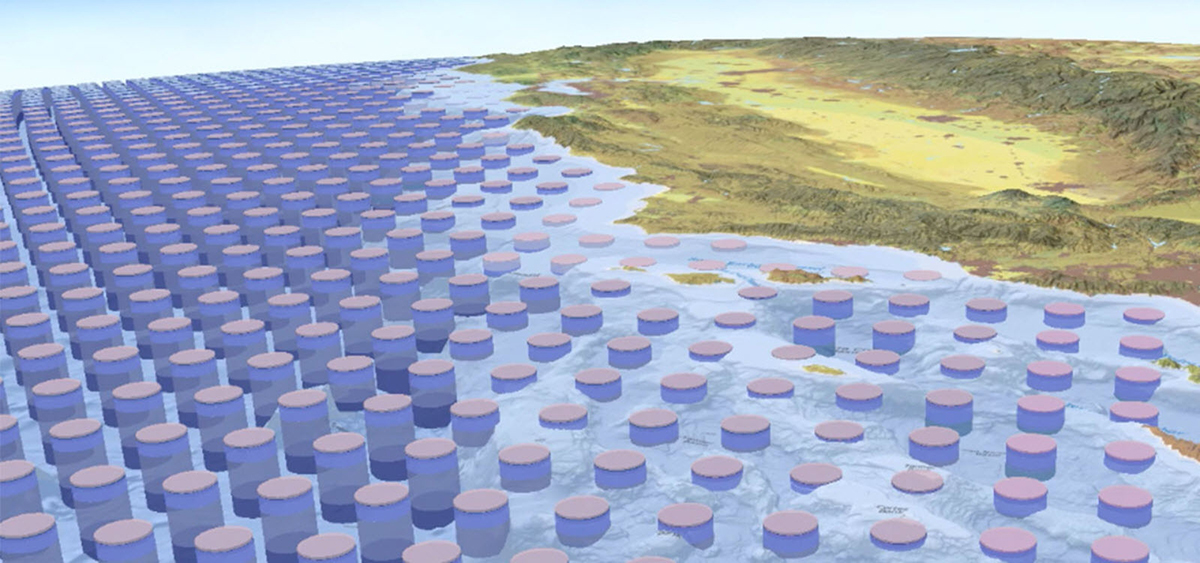what kinds of technology have helped us to explore the ocean
Here on Earth, we have more than detailed maps of Mars than of our ain bounding main, and that's a problem. A massive force for surviving climate change, the ocean absorbs 90% of the heat caused by emissions and generates 50% of the oxygen we breathe. "We have the ocean to give thanks for then many aspects of our condom and well-being," says Dawn Wright, oceanographer and master scientist at geographic information organisation (GIS) provider Esri, who notes the ocean likewise provides renewable energy, a major food source, and a transportation corridor for not only ships but submarine internet cables.
Now, the same type of smart maps and geospatial technology guiding outer infinite exploration back up the quest to better understand and protect our ocean. "For the first time, our knowledge of the ocean can arroyo our knowledge of the land," Wright says. "Nosotros tin plow the unknown deep into the known deep."
GIS—the location intelligence technology businesses and governments use for everything from risk mitigation to crisis response, market place analysis to operational efficiency—also applies to the bounding main. The logic is uncomplicated: the ocean supports a sustainable planet and economy, and information-rich maps can support a sustainable bounding main.

'Tons and tons of beautiful data'
More than eighty% of the sea floor remains unmapped, yet comprehensive sea maps will be essential for stemming the issues of overfishing, habitat destruction, pollution, and biodiversity loss. It's like shooting fish in a barrel, and at this point cliche, to say "save our sea," but a data-driven map compels people to see why the ocean needs saving, where to starting time, and what needs to be done. "Seeing the ocean in its true depth and complexity is exactly what we need if we hope to reduce the risk of critically dissentious or exhausting marine resources," Wright says.
Since its release in 2017, the world'southward first 3D sea map spurred a revolution of innovation in ocean-related information and sustainability solutions. The 3D digital bounding main map sorts global water masses into 37 distinct volumetric regions, known as ecological marine units, defined by factors in ecosystem health and recovery: temperature, salinity, oxygen, and food levels. Scientists, environmental managers, fishers, and shippers, as well as citizen scientists can use the map to virtually navigate and explore the ocean.
What makes the 3D map of the world'southward sea possible is the enterprise technology capable of collecting and processing data that comes in massive volume and diverseness. And there's more data on the fashion. "This whole idea of marine robotics is one of the big future visions for the bounding main," Wright says. "Robotics and sensors and other instruments are creating tons and tons and tons of beautiful data."
Once collected, those volumes of data go into a GIS where they are managed and processed, using artificial intelligence (AI) to quickly identify and classify information. The output of GIS, frequently called location intelligence, comes through as smart maps, spatial analytics, and real-fourth dimension dashboards—the aforementioned kind seen across the globe this past year to track and clarify the coronavirus pandemic. These GIS-powered interactive data visualization tools bring clarity even to the about complex of issues and assistance steer policy and commercial decisions based on a solid grasp of what'south happening now and what volition happen next.
"Nosotros tin fifty-fifty brand predictions in terms of what the information volition be telling us in 2030," Wright explains. "How warm will the coast of Florida exist in 2050? Will those temperatures kill off the bounding main grass in that expanse? Will those temperatures event in a red tide around Tampa that volition be so toxic it will kill all of the fisheries there?"
'The ocean is vulnerable'
Growing up on the Hawaiian Islands and working in American Samoa, Wright understands the ocean as a sacred place. That sentiment guides her work now with fellow scientists, regime leaders, and business executives. "I want people to understand that the ocean is vulnerable," Wright says. "What nosotros're doing to the sea right at present is having huge consequences. Our mean solar day-to-day weather and our long-term climate fully depend on the ocean."
For Wright, the establishment and enforcement of marine protected areas, such as Cook Islands Marine Park off of New Zealand and Papahānaumokuākea Marine National Monument in the Usa, represent a triumph in keeping the ocean protected. So far only 7% of the body of water has been marked as protected, compared to 15% of the land. "Fifty-fifty though we accept well-nigh 7% of the ocean protected in these parks or reserves, less than one-half of that is an area where you're not allowed to fish or have the corals or take the pretty rocks," Wright explains. "So, we take a long, long, long way to go there."

Protected areas, predictive maps, and pleas from scientists certainly make an impact on corporate and policy decisions. Add together to that increasing climate adventure and global pressure for social responsibility. These incentives, and the GIS tools needed to answer, are motivating leaders to implement new initiatives.
For example, shipping companies are working to decrease greenhouse gas emissions past designing more efficient vessels, a movement that furthers the sustainability cause while reducing business expense. Industries such every bit retail and manufacturing are putting circular economy principles in identify to repossess or recycle materials after the product has completed its original use. Aquaculture companies are selecting prime locations for responsible fish farming to assistance reduce overfishing, encourage aquatic ecosystem restoration, and recover endangered species.
Such efforts are moving united states of america toward the vision of a sustainable ocean and thus a sustainable planet. Although Wright feels certain with so much advanced engineering—"it'southward a cracking time to be mapping"—what's less sure is whether the work scientists, governments, and companies are doing will be enough or cede results soon enough.
'The body of water isn't as well large to fail'
Concerned virtually mounting threats to the ocean, the United Nations has alleged 2021 to 2030 the Decade of Ocean Science for Sustainable Development. "Information technology'southward like the Paris Climate Accord for the ocean," Wright says. "To me, information technology's the moonshot … to take something this focused for everybody—governments, universities, nonprofit organizations—this is a really big button."
A number of important ocean mapping projects are already in various stages of development and execution. For example, Seabed 2030 has the ambitious goal to map the entire ocean floor by the yr 2030. The Map of Biodiversity Importance shares habitat models for more than two,200 at-risk species in the face-to-face United States, featuring AI predictor layers for species viability based on development plans and environmental factors. And the Ocean Health Index annually assesses bounding main wellness by looking at social, ecological, and economic benefits to speed progress on bounding main policies.
Such projects will aid socially responsible companies (those edifice sustainability solutions to match concern opportunities) in achieving turn a profit while preserving the ocean. Their work often revolves around complex and real-time data, stored and processed with GIS, and presented on smart maps and data visualizations with GIS. Location intelligence helps companies—peculiarly shipping, energy, logistics, and angling industries—questions like the post-obit:
- Where would offshore wind turbines have the least impact on commercial fishing?
- Where should a new transatlantic submarine communications cable get to avert interference with scallop beds, rare deep-sea coral habitat, or sand mining areas needed for beach restoration?
- Where are appropriate areas for ships to transit in the Arctic (now that it'southward no longer covered with ice year-circular) to minimize the touch on sensitive ecosystems?
Equally the world slowly emerges from the pandemic and enters the United nations' Decade of Ocean Science for Sustainable Development, it can exercise so knowing companies, scientists, and policy makers have the power to make smarter choices for people and the planet.
Those choices will be guided past comprehensive data about the bounding main, the technology to map crucial information, and the agreement how, when, and where to intervene. The linchpin will exist making sustainability choices in time. "It turns out that the ocean is not too big to fail, unfortunately," Wright says. "The good news is that it'due south also not also large to fix."
This content was produced by Insights, the custom content arm of MIT Technology Review. It was not written by MIT Engineering science Review's editorial staff.
Source: https://www.technologyreview.com/2021/03/29/1021374/the-science-and-technology-that-can-help-save-the-ocean/
Postar um comentário for "what kinds of technology have helped us to explore the ocean"